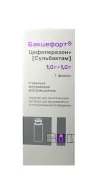Description
Cefixime Express Pharmacodynamics
Cefixime is a semi-synthetic broad-spectrum antibiotic of third generation cephalosporins for oral administration. It has a bactericidal effect. The mechanism of action is associated with inhibition of bacterial cell wall synthesis. Cefixime is resistant to β-lactamases produced by many Gram-positive and Gram-negative bacteria.
Spectrum of antimicrobial activity
In clinical practice and in vitro the efficacy of cefixime has been confirmed in infections caused by Streptococcus pneumoniae, Streptococcus pyogenes, Haemophilus influenzae, Moraxella catarrhalis, Escherichia coli, Proteus mirabilis, Neisseria gonorrhoeae.
Cefixime also has activity in vitro against Gram-positive – Streptococcus agalactiae and Gram-negative bacteria – Haemophilus parainfluenzae, Proteus vulgaris, Klebsiella pneumoniae, Klebsiella oxytoca, Pasteurella multocida, Providencia spp., Salmonella spp., Shigella spp., Citrobacter amalonaticus, Citrobacter diversus.
Pseudomonas spp., Enterococcus spp., Listeria monocytogenes, most strains of Enterobacter spp., Staphylococcusspp. (including methicillin-resistant strains), Bacteroides fragilis, Clostridium spp.
Indications
Infectious-inflammatory diseases caused by microorganisms sensitive to the drug:
– streptococcal tonsillitis and pharyngitis;
– sinusitis;
– acute bronchitis;
– exacerbation of chronic bronchitis;
– acute otitis media;
– Uncomplicated urinary tract infections;
– uncomplicated gonorrhea;
– shigellosis.
Contraindications .
– Hypersensitivity to cefixime or components of the drug;
– Hypersensitivity to cephalosporins or penicillins;
– not recommended for use in children with chronic renal insufficiency and in children weighing less than 25 kg in this dosage form.
Caution
Elderly age, renal failure, colitis (history), pregnancy.
Administration during pregnancy and lactation
Administration of the preparation Caefixime EXPRESS during pregnancy is possible in case when the expected benefits to the mother exceed the potential risk to the fetus. If it is necessary to apply the drug during lactation, breast-feeding should be discontinued.
Directions for use and dosages
- The daily dose for adults and children of body weight more than 50 kg is 400 mg in one or two doses.
- The preparation is administered in a single dose of 200 mg per day for children with body weight of 25-50 kg.
- The tablet can be swallowed with enough water or diluted in water and the resulting suspension can be drunk immediately after preparation. The drug may be taken regardless of meals.
- The duration of treatment depends on the nature of the course of the disease and the type of infection. After disappearance of infection symptoms and/or fever it is advisable to continue taking the drug for at least 48-72 hours.
- The course of treatment for infections of the respiratory tract and ENT-organ is 7-14 days.
- In tonsillopharyngitis caused by Streptococcus pyogenes, the duration of treatment should be at least 10 days.
- In uncomplicated gonorrhea, the drug is prescribed in a dose of 400 mg once.
- For uncomplicated lower urinary tract infections in women, the drug may be prescribed for 3-7 days, and for 14 days for uncomplicated upper urinary tract infections in women.
- For uncomplicated upper and lower urinary tract infections in men, the duration of treatment is 7-14 days.
- With impaired renal function, the dose is adjusted depending on serum creatinine clearance index. If creatinine clearance is 21-60 ml/min or in patients on hemodialysis, it is recommended to use other dosage forms of the drug due to necessity to decrease daily dose by 25%.
- When creatinine clearance is 20 ml/min or less or in patients on peritoneal dialysis, the daily dose should be reduced by half.





![Cefixime Express dispersible 400 mg - [7 tablets]](https://mediscom.com.co/wp-content/uploads/2022/11/Cefixime-Express-400mg-7.webp)




